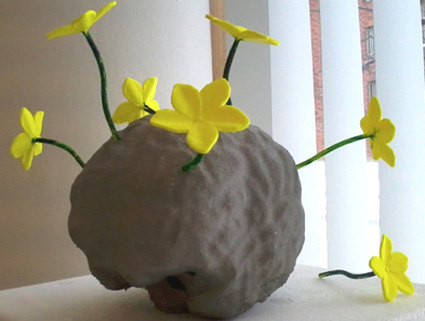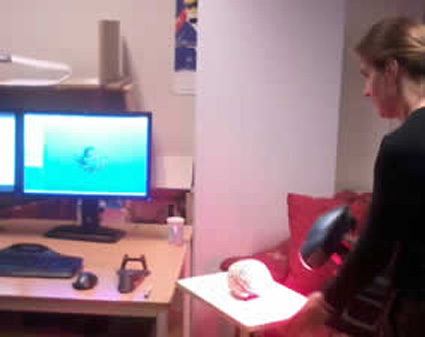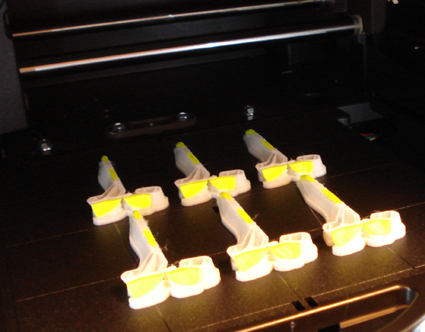Imagine being able to take your brain out and recharge it during the night, in the same mode as you do with your cell-phone today. During sleep you exchange it with an implant made in titanium since you really don't use any great brain-functions during sleep. In that case you can almost talk about cloning humans or even the possibility for eternal life, since our cociousness and thereby even soul is situated in our brains. That is the thoughts behind my 3D-print, that I made in co-operation with Sportstech in the Mittuniversitetet during a work-shop for fine artists and designers in the Jämtlands county.
Implants made in titanium is something that Sportstech often additive manufaturing, which is the correct phrase to use fo 3D-printing. These implants of eg. fracured bone structures are implanted, wfich I want to relate to in my project to manufature a brain additively in titanium.
|
|
|
We were eight fine artists and designers who in a December-Monday, 2013 began the project with Sportstechs computers, 3D-scanners and 3D-printers. To assist us twelve students at Sportstech were there. We continued our work in the lab on Campus in Östersund to be able to realize our ideas. We digitalised and scanned our models, made virtual 3D-models eventually printed them in the 3D-printers for plastic or titanium. The syudent Cecilia Larsen was my "tool", who made flowers in a 3D-program in the computer for me, thar we printed in plastic. The flowers were put into holes drilled in the printed brain that I had scanned and printed in titanium during the night. The resdearch group Sportstech the Mittuniversitetet held the workshop for fine artists and designers since "Artists is a group that has been fast in embracing the new techniwues with 3D-printers and they can give us intresting perspectives in how ths technique can be used. Internationally artists have proved that it is possible topush the boundaries for what 3D-printing can be used for", as Sportstechs lector in engineering technology, dr Lars-Erik Rännar says in the local TV-news Mittnytt. Sportstech cooperate with Regionalt designcentrum and Länskulturen Jämtland to "spread the know-how among artists and designers in the possibility to use 3D-printers as an artistic tool" in the project. |
|
|
|
It is however not "just" to scan (see above) the brain, since it is hard to reach every spot on it. I thing that my seventh try was good enough for the assising student to be able to helt me join allo the scannings into one picture. I must adnit that it was pretty awsome scanning with that sci-fi-gun! |
|
|
I
especially enjoyd when dr Lars-Erik
Rännar asked if they can use pictures of my project in
the fitire to show the possibilities. Of course thay can as long
as it says somewhere that the ideas are mine. That is the least
I can to do show my gratutude for all the help, material and all
the knoledge I have gotten through this project. |

Cecilia
Larsen helped me to draw flowers in at 3D-program in
the computer, which were printed in plastic. Here during the opening at
Designcentrum
in Östersund, behindUtopian Implant for the Future
|
In February 2014 the resultats from the workshopDå Nu 3D was shown in Regionalt designcentrum in Östersund. Togeather with me the participants were Aino Näslund who showed Cloned Smum Smum, Christer Widegren Exponentialhorn in titanium , Karolina Persson Autumnleaves, Kristina Wrang Who Pays ?, Katarina Widegren showed embroiderd feathers in titanium. "3D-printing, or additive manufaturing (AT), is a technique that has had a lot of attentieon lately. President Obama said that: ”Additive manufacturing has the potential to revolutionize the way we make almost everything.” (State of the Union Speech, Feb 2013). The technique builds an object, in many layers, from the information in a digital 3D-model and some of the advantages with the technique is the savings in material and a complete geometrcal freedom. In this project, Additive manufacturing as a competitive advantage, that has been financed by Mittuniversitetet and Tillväxtverket, students of the Sporttechnology-education have worked with fine artists and desigeners to realize the objects that are shown in the exhibitions. Students working in the project have been: Cecilia Larsson, David Sundén, Gustaf Bohman, Linnea JohnssonO, Niklas Ekstrand and Olof Molin Display and graphic design: Vanessa Sahlman". |
© MalinMatilda Allberg 2014


